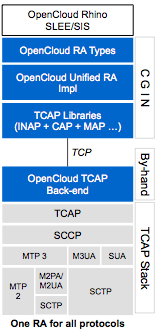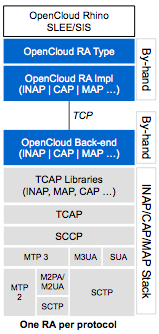Interfaces for SS7 protocols (such as INAP, CAP, and MAP) are provided by one resource adaptor. There is no need to install separate resource adaptors for INAP, CAP, and MAP as SS7 support has been unified.
The architecture behind this unification is illustrated by the following diagrams.
| new Unified RA | old IN RA |
|---|---|

CGIN technology now allows us to rapidly build our own support for INAP, CAP, and MAP — we do not need to rely on third parties for these layers any more. These application protocol layers now reside in the Java part of the resource adaptor (TCAP libraries in the diagram) and are used by the Unified Resource Adaptor implementation. These libraries not only provide support for their respective protocol, they also provide a corresponding resource adaptor type and metadata about the protocol. This Java "upper layer" has a single point of integration to a TCAP back end that encapsulates a TCAP stack from a third-party vendor. |

In contrast, our old SS7 resource adaptors required hand-crafted adaptation per protocol to integrate with third-party vendor APIs for INAP, CAP, and MAP. The architecture of our old RAs is similar (Java front end, native back end); however this approach meant we needed a Java front end per protocol and a native back end per protocol. Whilst our old SS7 resource adaptors work extremely well, their approach means there is more code to maintain, and our ability to address incompatibilities in the support for application protocols and proprietary variants is limited. CGIN technology removes these barriers completely! |
